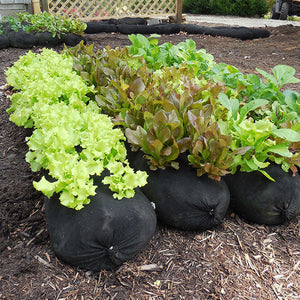This Winter Squash variety is a delicious addition to your fall garden, and once you learn how to grow Acorn Squash, you will see that it also yields an abundant harvest. While the hard outer rind is not edible, a sufficiently ripe Acorn Squash is mildly sweet inside and has a creamy texture when baked. Squash is high in fiber and contains a good amount of Vitamin C, Vitamin B6 and Magnesium.
Bake with a sprinkle of brown sugar to bring out the sweetness, or use acorn squash as a substitute for sweet potato or pumpkin in pie, bread or muffin recipes. Acorn Squash are also an excellent source of potassium, even more so than bananas.

Growing acorn squash in GardenSoxx® | Plant Family: Cucurbitaceae
Different Varieties of Acorn Squash
While there are many different varieties of acorn squash, those listed below would make great options for the home garden.
Early Acorn squash is perfect for growing in smaller spaces and has a slightly shorter growing time of around 75 days.
Cream of the Crop grows on more compact vines, has a pleasantly nutty but mild taste and a very light, slightly yellow color.
Heart of Gold acorn squash offer higher yields than some other varieties, and their white and green coloring make them an attractive addition to fall table decor.
The Table Queen is a popular favorite for home gardeners as they grow to a consistent, uniform size and have a thinner rind than other varieties.
Nutritional Information For Acorn Squash
Nutritional Facts - per 100/g
| Nutrient | Amount | % Daily Value |
|---|---|---|
| Calories | 40 | - |
| Total Fat | 0.1 g | - |
| Sodium | 3 mg | - |
| Potassium | 347 mg | - |
| Dietary Fiber | 1.5 g | - |
| Sugar | 0 g | - |
| Protein | 0.8 g | - |
| Vitamin C | - | 18% |
| Iron | - | 3% |
| Vitamin B6 | - | 10% |
| Magnesium | - | 8% |
| Calcium | - | 3% |
How to Grow Acorn Squash in Your GardenSoxx®
Seeds can be direct sown into soil about two weeks after the final spring frost, up until about 14 weeks before the first fall frost. Acorn Squash need warm weather to promote growth and are best suited for warmer growing zones. Be sure to give each plant sufficient room to grow and avoid planting them too close together. Plants should be watered often to ensure the soil stays moist throughout their early growth.
Acorn Squash Seed to Harvest Time: 80 - 100 days

How to Harvest Acorn Squash
Fruit should be harvested before any hard frost sets in. Cut from the vine, being careful not to damage any other vines that may be producing more squash. Acorn Squash should be cured in the sun for about a week before putting them in longer-term storage. They will keep well for several weeks if stored in a cool, dry environment.























































